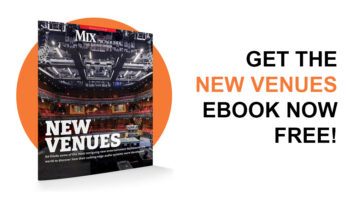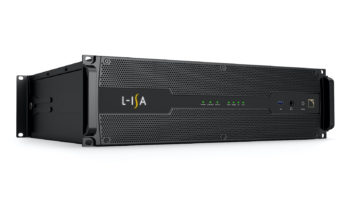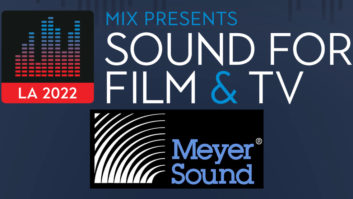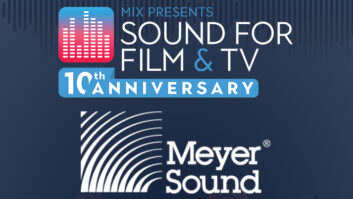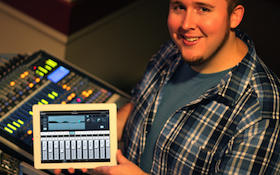
The author, Derrick Jeror, with iPad.
I work in live sound, and I’m done with audio snakes. No, I don’t mean I’ve switched from copper to Cat 5. I mean that I’m done, totally, forever. And my mixer? I have one, but you won’t see it. It’s behind the stage. And my iPad? No, I’m not playing Angry Birds, I’m mixing the band from the best seat in the house, right next to my wife and kids. I don’t even think about monitors anymore, the band takes care of them on their own. And because there’s no snake, stage racks or separate monitor system, everything takes less than 20 minutes to set up. Just put the mixer near the stage, connect the band and powered speakers, and go. Even crazier, an entire system for a 600-seat venue can fit in a Honda Civic. Oh, did I mention I’m doing all of this with a $1,999 mixer and some free apps? Welcome to the future of portable sound.
Because of my line of work at Housetop Media—a bit of installs, retailing, mixing, audio consulting, with an emphasis on portable churches—I’m obsessed with setup and tear-down efficiency. I’m also obsessed with cutting-edge technology. About three years ago, my never-ending search led me to the PreSonus StudioLive line of digital mixers. They were cost-effective, compact and powerful, but I wouldn’t say revolutionary. When I got my first StudioLive it only came with Capture (a multitrack recording program) and StudioOne (PreSonus’ DAW). The revolutionary stuff came with the software releases and firmware updates that followed.
First came VSL (Virtual StudioLive), a computer program that provides a control interface and a backup for your preset library. Next came SL Remote, an iPad app that lets you mix over Wi-Fi. Most recently the company released an app called QMix. It’s a personal monitor-mixing app that works on iPhone and iPod Touch. These apps and computer programs have totally transformed how I design portable sound systems and how they operate.
FOH, Wherever You Sit
Have you ever arrived at a venue to find the FOH location is either up in a balcony or back in some “sound room” with a hole in the wall? With the mixer onstage and SL Remote on my iPad, I can pick from any spot in the room to mix. The only time I am physically at the mixer is to set the analog gain knobs and load channel presets when the band first arrives. After that, it’s all iPad. I know mixing on a touchscreen instead of knobs and faders may seem like heresy to seasoned road dogs. But after giving it a chance, I have to let you in on my dirty little secret…I actually like it better than mixing on the console.
With the large display I can quickly scan and see EQ, gate, compressor, panning, routing, mutes and fader settings for every channel from a single overview screen. I can directly manipulate parametric EQ curves by touching and pinching. My iPad finally feels like the “magical” device Steve Jobs told me it would be. On top of the features already mentioned, you also have control of eight assignable 31-band graphic EQs (if you are working on StudioLive 24.4.2), aux channel control, effects including tap tempo, scene loading, channel naming and talkback mic control—with a wireless mic you can talk to specific members of the band from anywhere in the room. And because the controls are so visual, I find it’s a great teaching tool for new sound engineers. Suddenly compressor thresholds and ratios make sense to a kid once they see and hear the changes at the same time.
Because Wi-Fi can be flaky depending on where you are, I always bring an Airport Express for my private network, giving me an additional stereo audio output that I connect to the StudioLive. Using AirPlay, I can play audio wirelessly from my iPad through the system from anywhere in the room. I use it to play music before and after church services and events. Also, using a remote desktop app on the iPad, I can control the computer that’s connected to the mixer. That lets me remotely start and stop recordings in Capture or play back audio files from the computer.

Monitor Mixing? There’s an App for That
Most churches I work with don’t have the financial or volunteer resources to have separate FOH and monitor consoles. So the part-time, volunteer FOH guy is expected to mix multiple monitors, a separate recording mix and the main mix, and everyone expects it to sound as good as a U2 concert. Let’s top that off with the fact there may be only an hour to set up, soundcheck and run through the song set before service starts. And people wonder why sound guys tend to be grumpy and mumble to themselves a lot?
For those reasons I’ve been a big proponent of personal monitor-mixing systems like those from Aviom. The band can quickly get the mix they want and it lets the FOH guy focus on the house sound. The biggest drawbacks to these types of systems are extra setup time, stage clutter, inability for the FOH guy to remotely help someone with their mix, and, for most smaller churches, the cost can be prohibitive. A six-seat Aviom system can cost upward of $6,000, and that doesn’t include the cost of in-ear monitors. I’m not bashing Aviom or similar systems; they have their place and they work great, if you have the budget. I often don’t.
With QMix each band member controls his or her own aux channel or stereo aux pair. If you already have monitors and either an iPhone, iPad or iPod Touch, it doesn’t cost a dime. Bands can even share a single iPad and pass it around during practice. But if everyone has their own device, you can assign each device to that person’s monitor mix so they can’t accidentally mess with someone else’s mix. Because I leave the mixer right up by the stage, I can use a single PreSonus HP60 headphone amp to create a six-person in-ear monitor system for less than $300. To add mobility, I use Elite Core’s wired IEM belt-packs that cost around $20 and let you move around stage without cables tugging at your ears. Unless a musician absolutely has to go wireless, I always prefer wired due to better sound quality, reliability and much lower price. There are also other benefits to QMix.
First, you have direct control of every input on the mixer, with independent control of effect levels in your monitor mix; most systems limit you to 16 channels. Second, you can assign each band member to either have complete control of their monitor mix or just give the 80-year-old pianist the “Wheel of Me” that lets her simply turn herself up or down. Likewise, you can group channels, so, for example, once a drummer gets the eight-mic kit balanced, they can turn the entire kit up or down but still have access to make individual channel tweaks when needed. Third, you can name all the channels on the computer, and channel names show up on everyone’s devices. No more writing on masking tape! And finally, as mentioned but worth repeating: Less stage clutter and quicker setup and teardown.
There are some disadvantages, too, if you’re used to working on a more traditional system. For starters, the number of individual monitor mixes is limited by the number of aux channels, which ranges from four on the 16.0.2 up to 10 on the 24.4.2. Also, some people just prefer physical knobs. And finally, again worth repeating, flaky Wi-Fi can be an issue, so bring a router and set up your own private network.
Road Dog, New Tricks
I completely understand that this type of setup is a massive paradigm shift and isn’t for everybody. But if you’re a small- to medium-size church or band on a limited budget and are willing to try something different, I don’t think you can find a better solution for the money. Every church I design this type of system for is always nervous about the idea of not having a snake and not putting the mixer in the back of the room. And every one of them comes back to thank me for pushing them to think differently. You’ll save money, get more functionality and, if you’re portable, drastically reduce setup and tear-down time.
This year PreSonus is going to see new competition from Mackie, Line 6, Behringer and others, no doubt. But the company isn’t sitting still, releasing new features like integrated SMAART analysis. In today’s world, software is just as important as hardware, so the developments will be interesting to watch. One thing is certain, though, portable sound has changed forever. And this is just the beginning…
Derrick Jeror is the founder of Housetop Media in Corning, N.Y., where he specializes in system design for houses of worship.

